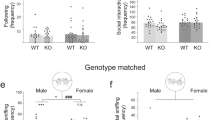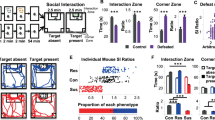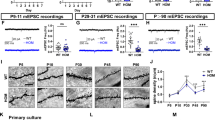Abstract
The anterior insular cortex (aIC) is involved in multiple neuropsychiatric disorders. Here, using the Cntnap2-deficient autism spectrum disorder (ASD) mouse model and the chronic social defect stress (CSDS)-induced depression mouse model, we show that two subpopulations of microglia in the mouse aIC played differential roles in ASD-like and depression-like behavioral phenotypes differentially. The Cx3cr1+ microglia had morphological deficits in the Cntnap2-deficient mice and were involved in social deficits and restricted repetitive behaviors, while the Tmem119+ microglia had morphological deficits in the CSDS-induced mice and contributed to impairments in sucrose preference and forced swim performance. Further, we showed that the two subsets of microglia had differential features in morphology, transcriptional profiles, electrophysiological properties, and impacts on synaptic functions. Using proteomic and metabonomic analyses, we identified two secretory factors, Fbl and Hp1bp3, that were crucial for the dysfunctions of the Cx3cr1+ and Tmem119+ microglia, respectively. Finally, we verified that Fbl and Hp1bp3 played essential roles in the behavioral deficits of the Cntnap2-deficient and the CSDS-induced mice, respectively. Our study can help understand the contribution of microglia and the aIC to neuropsychiatric-like behaviors.
This is a preview of subscription content, access via your institution
Access options
Subscribe to this journal
Receive 12 print issues and online access
$259.00 per year
only $21.58 per issue
Buy this article
- Purchase on SpringerLink
- Instant access to full article PDF
Prices may be subject to local taxes which are calculated during checkout








Similar content being viewed by others
Data availability
All data supporting the findings of this study are included in this paper and the supplementary materials. Metabonomics and scRNA-seq data of microglia are available in the CNSA database (Accession number: CNP0007796). Proteomics data are available in the Integrated Proteome Resources (iProX) database (Accession number: IPX0012891000).
References
Chen YF, Song Q, Colucci P, Maltese F, Siller-Pérez C, Prins K, et al. Basolateral amygdala activation enhances object recognition memory by inhibiting anterior insular cortex activity. Proc Natl Acad Sci USA. 2022;119:e2203680119.
Uddin LQ. Salience processing and insular cortical function and dysfunction. Nat Rev Neurosci. 2015;16:55–61.
Menon V, Uddin LQ. Saliency, switching, attention and control: a network model of insula function. Brain Structure Funct. 2010;214:655–67.
Namkung H, Kim SH, Sawa A. The Insula: an underestimated brain area in clinical neuroscience, psychiatry, and neurology. Trends Neurosci. 2017;40:200–7.
Gogolla N, Takesian AE, Feng G, Fagiolini M, Hensch TK. Sensory integration in mouse insular cortex reflects GABA circuit maturation. Neuron. 2014;83:894–905.
Caria A, de Falco S. Anterior insular cortex regulation in autism spectrum disorders. Front Behav Neurosci. 2015;9:38.
Moran LV, Tagamets MA, Sampath H, O’Donnell A, Stein EA, Kochunov P, et al. Disruption of anterior insula modulation of large-scale brain networks in schizophrenia. Biol Psychiatry. 2013;74:467–74.
Palaniyappan L, Simmonite M, White Thomas P, Liddle Elizabeth B, Liddle Peter F. Neural primacy of the salience processing system in schizophrenia. Neuron. 2013;79:814–28.
Kühn S, Gallinat J. Common biology of craving across legal and illegal drugs – a quantitative meta-analysis of cue-reactivity brain response. Eur J Neurosci. 2011;33:1318–26.
Engelmann JM, Versace F, Robinson JD, Minnix JA, Lam CY, Cui Y, et al. Neural substrates of smoking cue reactivity: a meta-analysis of fMRI studies. Neuroimage. 2012;60:252–62.
Bonthius DJ, Solodkin A, Van Hoesen GW. Pathology of the insular cortex in alzheimer disease depends on cortical architecture. J Neuropathol Exp Neurol. 2005;64:910–22.
Ginhoux F, Greter M, Leboeuf M, Nandi S, See P, Gokhan S, et al. Fate mapping analysis reveals that adult microglia derive from primitive macrophages. Science. 2010;330:841–5.
Wlodarczyk A, Holtman IR, Krueger M, Yogev N, Bruttger J, Khorooshi R, et al. A novel microglial subset plays a key role in myelinogenesis in developing brain. EMBO J. 2017;36:3292–308.
Li Y, Du XF, Liu CS, Wen ZL, Du JL. Reciprocal regulation between resting microglial dynamics and neuronal activity in vivo. Dev Cell. 2012;23:1189–202.
Cornell J, Salinas S, Huang HY, Zhou M. Microglia regulation of synaptic plasticity and learning and memory. Neural Regen Res. 2022;17:705–16.
Lukens JR, Eyo UB. Microglia and neurodevelopmental disorders. Annu Rev Neurosci. 2022;45:425–45.
Cserép C, Pósfai B, Lénárt N, Fekete R, László ZI, Lele Z, et al. Microglia monitor and protect neuronal function through specialized somatic purinergic junctions. Science. 2020;367:528–37.
Setiawan E, Wilson AA, Mizrahi R, Rusjan PM, Miler L, Rajkowska G, et al. Role of translocator protein density, a marker of neuroinflammation, in the brain during major depressive episodes. JAMA Psychiatry. 2015;72:268–75.
Torres-Platas SG, Cruceanu C, Chen GG, Turecki G, Mechawar N. Evidence for increased microglial priming and macrophage recruitment in the dorsal anterior cingulate white matter of depressed suicides. Brain Behav Immun. 2014;42:50–59.
Böttcher C, Fernández-Zapata C, Snijders GJL, Schlickeiser S, Sneeboer MAM, Kunkel D, et al. Single-cell mass cytometry of microglia in major depressive disorder reveals a non-inflammatory phenotype with increased homeostatic marker expression. Transl Psychiatry. 2020;10:310.
Steiner J, Bielau H, Brisch R, Danos P, Ullrich O, Mawrin C, et al. Immunological aspects in the neurobiology of suicide: elevated microglial density in schizophrenia and depression is associated with suicide. J Psychiatr Res. 2008;42:151–7.
Suzuki K, Sugihara G, Ouchi Y, Nakamura K, Futatsubashi M, Takebayashi K, et al. Microglial activation in young adults with autism spectrum disorder. JAMA Psychiatry. 2013;70:49–58.
Öngür D, Drevets WC, Price JL. Glial reduction in the subgenual prefrontal cortex in mood disorders. Proc Natl Acad Sci. 1998;95:13290–5.
Réus GZ, Fries GR, Stertz L, Badawy M, Passos IC, Barichello T, et al. The role of inflammation and microglial activation in the pathophysiology of psychiatric disorders. Neuroscience. 2015;300:141–54.
Bennett ML, Bennett FC, Liddelow SA, Ajami B, Zamanian JL, Fernhoff NB, et al. New tools for studying microglia in the mouse and human CNS. Proc Natl Acad Sci. 2016;113:E1738–E1746.
Favuzzi E, Huang S, Saldi GA, Binan L, Ibrahim LA, Fernandez-Otero M, et al. GABA-receptive microglia selectively sculpt developing inhibitory circuits. Cell. 2021;184:5686.
Zrzavy T, Hametner S, Wimmer I, Butovsky O, Weiner HL, Lassmann H. Loss of ‘homeostatic’ microglia and patterns of their activation in active multiple sclerosis. Brain. 2017;140:1900–13.
Cao P, Chen C, Liu A, Shan Q, Zhu X, Jia C, et al. Early-life inflammation promotes depressive symptoms in adolescence via microglial engulfment of dendritic spines. Neuron. 2021;109:2573–2589 e2579.
Lawson LJ, Perry VH, Dri P, Gordon S. Heterogeneity in the distribution and morphology of microglia in the normal adult mouse brain. Neuroscience. 1990;39:151–70.
De Biase LM, Schuebel KE, Fusfeld ZH, Jair K, Hawes IA, Cimbro R, et al. Local Cues establish and maintain region-specific phenotypes of Basal Ganglia Microglia. Neuron. 2017;95:341–356.e346.
Schmid CD, Sautkulis LN, Danielson PE, Cooper J, Hasel KW, Hilbush BS, et al. Heterogeneous expression of the triggering receptor expressed on myeloid cells-2 on adult murine microglia. J Neurochem. 2002;83:1309–20.
Wu S, Nguyen LTM, Pan H, Hassan S, Dai Y, Xu J, et al. Two phenotypically and functionally distinct microglial populations in adult zebrafish. Sci Adv. 2020;6:eabd1160.
Stratoulias V, Ruiz R, Kanatani S, Osman AM, Keane L, Armengol JA, et al. ARG1-expressing microglia show a distinct molecular signature and modulate postnatal development and function of the mouse brain. Nat Neurosci. 2023;26:1008–20.
Stephan DA. Unraveling autism. Am J Hum Genet. 2008;82:7–9.
Alarcon M, Abrahams BS, Stone JL, Duvall JA, Perederiy JV, Bomar JM, et al. Linkage, association, and gene-expression analyses identify CNTNAP2 as an autism-susceptibility gene. Am J Hum Genet. 2008;82:150–9.
Penagarikano O, Abrahams BS, Herman EI, Winden KD, Gdalyahu A, Dong H, et al. Absence of CNTNAP2 leads to epilepsy, neuronal migration abnormalities, and core autism-related deficits. Cell. 2011;147:235–46.
Satoh J, Kino Y, Asahina N, Takitani M, Miyoshi J, Ishida T, et al. TMEM119 marks a subset of microglia in the human brain. Neuropathology. 2016;36:39–49.
Armbruster BN, Li X, Pausch MH, Herlitze S, Roth BL. Evolving the lock to fit the key to create a family of G protein-coupled receptors potently activated by an inert ligand. Proc Natl Acad Sci USA. 2007;104:5163–8.
Yasumoto Y, Stoiljkovic M, Kim JD, Sestan-Pesa M, Gao X-B, Diano S, et al. Ucp2-dependent microglia-neuronal coupling controls ventral hippocampal circuit function and anxiety-like behavior. Mol Psychiatry. 2021;26:2740–52.
Woodburn SC, Bollinger JL, Wohleb ES. The semantics of microglia activation: neuroinflammation, homeostasis, and stress. J Neuroinflammation. 2021;18:258.
Ueshima S, Nagata K, Okuwaki M. Upstream binding factor-dependent and pre-rRNA transcription-independent association of pre-rRNA processing factors with rRNA gene. Biochem Biophys Res Commun. 2014;443:22–27.
Shang M, Weng L, Wu S, Liu B, Yin X, Wang Z, et al. HP1BP3 promotes tumor growth and metastasis by upregulating miR-23a to target TRAF5 in esophageal squamous cell carcinoma. Am J Cancer Res. 2021;11:2928–43.
Reiss K, Cornelsen I, Husmann M, Gimpl G, Bhakdi S. Unsaturated fatty acids drive disintegrin and metalloproteinase (ADAM)-dependent cell adhesion, proliferation, and migration by modulating membrane fluidity. J Biol Chem. 2011;286:26931–42.
Li D, Tong Y, Li Y. Associations between dietary oleic acid and linoleic acid and depressive symptoms in perimenopausal women: the study of women’s health across the nation. Nutrition. 2020;71:110602.
Hermans EJ, Henckens MJAG, Joëls M, Fernández G. Dynamic adaptation of large-scale brain networks in response to acute stressors. Trends Neurosci. 2014;37:304–14.
Downar J, Blumberger DM, Daskalakis ZJ. The neural crossroads of psychiatric illness: an emerging target for brain stimulation. Trends Cognit Sci. 2016;20:107–20.
Goodkind M, Eickhoff SB, Oathes DJ, Jiang Y, Chang A, Jones-Hagata LB, et al. Identification of a Common Neurobiological Substrate for Mental Illness. JAMA Psychiatry. 2015;72:305–15.
Stratmann M, Konrad C, Kugel H, Krug A, Schöning S, Ohrmann P, et al. Insular and hippocampal gray matter volume reductions in patients with major depressive disorder. PLoS ONE. 2014;9:e102692.
Huang Y, Xu Z, Xiong S, Sun F, Qin G, Hu G, et al. Repopulated microglia are solely derived from the proliferation of residual microglia after acute depletion. Nat Neurosci. 2018;21:530–40.
Najafi AR, Crapser J, Jiang S, Ng W, Mortazavi A, West BL, et al. A limited capacity for microglial repopulation in the adult brain. Glia. 2018;66:2385–96.
Rogers JT, Morganti JM, Bachstetter AD, Hudson CE, Peters MM, Grimmig BA, et al. CX3CR1 deficiency leads to impairment of hippocampal cognitive function and synaptic plasticity. J Neurosci. 2011;31:16241–50.
Zhan Y, Paolicelli RC, Sforazzini F, Weinhard L, Bolasco G, Pagani F, et al. Deficient neuron-microglia signaling results in impaired functional brain connectivity and social behavior. Nat Neurosci. 2014;17:400–6.
Slouzkey I, Rosenblum K, Maroun M. Memory of conditioned taste aversion is erased by inhibition of PI3K in the insular cortex. Neuropsychopharmacology. 2013;38:1143–53.
Hellwig S, Brioschi S, Dieni S, Frings L, Masuch A, Blank T, et al. Altered microglia morphology and higher resilience to stress-induced depression-like behavior in CX3CR1-deficient mice. Brain Behav Immun. 2016;55:126–37.
Liu X, Yu Z, Li Y, Huang J. CX3CL1 and its receptor CX3CR1 interact with RhoA signaling to induce paclitaxel resistance in gastric cancer. Heliyon. 2024;10:e29100.
Cangalaya C, Sun W, Stoyanov S, Dunay IR, Dityatev A. Integrity of neural extracellular matrix is required for microglia-mediated synaptic remodeling. Glia. 2024;72:1874–92.
Li L, Xu N, He Y, Tang M, Yang B, Du J, et al. Dehydroervatamine as a promising novel TREM2 agonist, attenuates neuroinflammation. Neurotherapeutics. 2025;22:e00479.
Umpierre AD, Wu LJ. How microglia sense and regulate neuronal activity. Glia. 2021;69:1637–53.
Davalos D, Grutzendler J, Yang G, Kim JV, Zuo Y, Jung S, et al. ATP mediates rapid microglial response to local brain injury in vivo. Nat Neurosci. 2005;8:752–8.
Nimmerjahn A, Kirchhoff F, Helmchen F. Resting microglial cells are highly dynamic surveillants of brain parenchyma in vivo. Science. 2005;308:1314–8.
Walker DG, Lue L-F. Immune phenotypes of microglia in human neurodegenerative disease: challenges to detecting microglial polarization in human brains. Alzheimer’s Res Ther. 2015;7:56.
Raj DDA, Jaarsma D, Holtman IR, Olah M, Ferreira FM, Schaafsma W, et al. Priming of microglia in a DNA-repair deficient model of accelerated aging. Neurobiol Aging. 2014;35:2147–60.
Barreto C, Curtin A, Topoglu Y, Day-Watkins J, Garvin B, Foster G, et al. Prefrontal cortex responses to social video stimuli in young children with and without autism spectrum disorder. Brain Sci. 2024;14:503.
Bove M, Palmieri MA, Santoro M, Agosti LP, Gaetani S, Romano A, et al. Amygdalar neurotransmission alterations in the BTBR mice model of idiopathic autism. Transl Psychiatry. 2024;14:193.
Yao Y, Li Q. The role of parvalbumin interneurons in autism spectrum disorder. J Neurosci Res. 2024;102:e25391.
Zheng J, Zhang XM, Tang W, Li Y, Wang P, Jin J, et al. An insular cortical circuit required for itch sensation and aversion. Curr Biol. 2024;34:1453–1468 e1456.
Taxier LR, Neira S, Flanigan ME, Haun HL, Eberle MR, Kooyman LS, et al. Retrieval of an ethanol-conditioned taste aversion promotes GABAergic plasticity in the anterior insular cortex. J Neurosci. 2025;45:e0525242024.
Taylor A, Adank DN, Young PA, Quan Y, Nabit BP, Winder DG. Forced abstinence from volitional ethanol intake drives a vulnerable period of hyperexcitability in BNST-projecting insular cortex neurons. J Neurosci. 2024;44:e1121232023.
Del Vecchio M, Avanzini P, Gerbella M, Costa S, Zauli FM, d’Orio P, et al. Anatomo-functional basis of emotional and motor resonance elicited by facial expressions. Brain. 2024;147:3018–31.
Park S, Huh Y, Kim JJ, Cho J. Bidirectional fear modulation by discrete anterior insular circuits in male mice. eLife. 2024;13:RP95821.
Sullivan O, Ciernia AV. Work hard, play hard: how sexually differentiated microglia work to shape social play and reproductive behavior. Front Behav Neurosci. 2022;16:989011.
Gabele L, Bochow I, Rieke N, Sieben C, Michaelsen-Preusse K, Hosseini S, et al. H7N7 viral infection elicits pronounced, sex-specific neuroinflammatory responses in vitro. Front Cell Neurosci. 2024;18:1444876.
Lazzarini G, Gatta A, Miragliotta V, Vaglini F, Viaggi C, Pirone A. Glial cells are affected more than interneurons by the loss of Engrailed 2 gene in the mouse cerebellum. J Anat. 2024;244:667–75.
Ugursu B, Sah A, Sartori S, Popp O, Mertins P, Dunay IR, et al. Microglial sex differences in innate high anxiety and modulatory effects of minocycline. Brain Behav Immun. 2024;119:465–81.
Guneykaya D, Ugursu B, Logiacco F, Popp O, Feiks MA, Meyer N, et al. Sex-specific microglia state in the Neuroligin-4 knock-out mouse model of autism spectrum disorder. Brain Behav Immun. 2023;111:61–75.
Shi W, Fu Y, Shi T, Zhou W. Different synaptic plasticity after physiological and psychological stress in the anterior insular cortex in an observational fear mouse model. Front Synaptic Neurosci. 2022;14:851015.
Yang EJ, Frolinger T, Iqbal U, Estill M, Shen L, Trageser KJ, et al. The role of the Toll like receptor 4 signaling in sex-specific persistency of depression-like behavior in response to chronic stress. Brain Behav Immun. 2024;115:169–78.
Golden SA, Covington HE 3rd, Berton O, Russo SJ. A standardized protocol for repeated social defeat stress in mice. Nat Protoc. 2011;6:1183–91.
Mertens J, Wang QW, Kim Y, Yu DX, Pham S, Yang B, et al. Differential responses to lithium in hyperexcitable neurons from patients with bipolar disorder. Nature. 2015;527:95–99.
Zheng Y, Shen W, Zhang J, Yang B, Liu YN, Qi H, et al. CRISPR interference-based specific and efficient gene inactivation in the brain. Nat Neurosci. 2018;21:447–54.
Acknowledgements
We thank Xiaxia Duan, Xin-Yu She, and Songhai Shi (Tsinghua University) for technical and material help. We thank all members of the laboratory for helpful discussion. This work was supported by the Beijing Natural Science Foundation (Grant No. Z210011), the National Natural Science Foundation of China (NSFC) (Grant No. 32371008, 31830038), the Open Project of Collaborative Innovation Center for Language Ability of Jiangsu Province, China, and funding from Tsingha-Peking Center for Life Sciences.
Author information
Authors and Affiliations
Contributions
Q.M.Z. and Y.F.C. performed the behavioral, biochemical, proteomic, and metabonomic experiments. Y.Y.X., M.Y., and S.Y.L performed the electrophysiology experiments. Q.M.Z., Y.F.C. and N.L. performed the imaging experiments. X.J. performed the molecular biology experiments. H.G. performed the scRNA-seq analysis. J.Y. wrote the manuscript with inputs from all authors. All authors read and approved the final manuscript.
Corresponding author
Ethics declarations
Competing interests
The authors declare no competing interests.
Additional information
Publisher’s note Springer Nature remains neutral with regard to jurisdictional claims in published maps and institutional affiliations.
Supplementary information
Rights and permissions
Springer Nature or its licensor (e.g. a society or other partner) holds exclusive rights to this article under a publishing agreement with the author(s) or other rightsholder(s); author self-archiving of the accepted manuscript version of this article is solely governed by the terms of such publishing agreement and applicable law.
About this article
Cite this article
Zhang, QM., Chen, YF., Xing, YY. et al. Anterior insular cortex regulates depression-like and ASD-like behaviors via the differential contribution of two subsets of microglia. Mol Psychiatry (2025). https://doi.org/10.1038/s41380-025-03139-1
Received:
Revised:
Accepted:
Published:
DOI: https://doi.org/10.1038/s41380-025-03139-1



